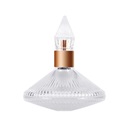READ NEXT
What can I protect overseas?
You might be able to protect your trade mark, invention, design or plant variety in another country. The level and length of protection depends on the country's regulations. You'll also need to meet their eligibility requirements for IP rights.
Examples of IP rights protected overseas

Trade mark
Nike swoosh logo

Patent
Gardasil vaccine

Design
Charlotte Tilbury perfume bottle

Plant variety
Apple variety (ANABP 01)
The name of the of IP right can change depending on the country. In some places:
- design rights are referred to as industrial designs, registered designs or design patents
- plant breeder's rights are known as plant variety rights or plant variety protection.
How does it work?
Here's a quick video that explains how to protect your IP overseas.
What is international intellectual property?
Just because you’ve protected your intellectual property – or IP – in Australia, it doesn’t mean you’re protected internationally.
To secure protection for your trade mark, invention, design, or plant variety in another country, you’ll need to apply for IP rights there.
Securing an IP right in your target country can increase your competitive advantage with protection of your IP assets. It can also help to establish your market position, stop local competitors from stealing your ideas, and reduce your risk of infringing existing IP in the market.
Keep in mind that the level and length of protection depends on the country’s laws, and you’ll also need to meet their eligibility requirements for IP rights.
If you delay getting protection, it might be tricky for you to secure your IP rights later on.
Want to learn more? Check out our International IP page.
Why should I protect my IP overseas?
Securing an IP right in your target country can:
- increase your competitive advantage with proactive protection of your IP assets
- help establish your market position
- stop local competitors from imitating or stealing your ideas
- reduce your risk of infringing existing IP in the market
- minimise the risk of IP breaches
- avoid damaging your brand.
If you delay getting protection, it might be tricky for you to secure your IP rights later on.
How does it work?
The application process depends on the type of IP you want to protect, the method you choose and your target country's systems. Overall, you'll generally need to:
- determine what type of IP right you need
- check if your trade mark, invention, design or plant variety is eligible for protection in that country
- assess the cost of applying for protection and associated ongoing management fees
- conduct a thorough search for similar trade marks, inventions, designs or plant varieties
- decide if you want to apply directly to the country's IP office or through an international cooperation system.
How to apply International cooperation
If you've already applied for IP protection in Australia, you can use the Paris Convention to help protect your IP in other countries. It lets you claim the same filing date in your overseas application, as long as you file it within 6 to 12 months of your original application. The filing timeframe varies depending on the type of IP right.
The Paris Convention doesn't apply to plant breeder's rights.
How the Paris convention works
Common myths about overseas IP
"Once my IP is protected in Australia, it's protected everywhere"
IP rights are territorial. This means trade marks, patents, design rights and plant breeder's rights registered in Australia are only protected within Australia. If you want to secure your IP rights globally, you'll need to apply for IP protection in each country where you want to operate.
"I can get a worldwide IP right"
There is no such thing as a worldwide IP right because there isn't an international system that protects IP rights globally. However, there are systems that can help protect your IP in many countries at once. Application requirements depend on where you want to expand and the type of IP right involved. Not all countries protect each type of IP right.
"I can get protected in multiple countries with one application"
Not quite. If you file through an international cooperation system, you'll be able to start by filing a single application to cover your trade mark, patent or design in multiple countries. You may need to take further steps depending on the type of IP and the country where you're applying.
If you file directly through individual countries, you'll need to submit separate applications to each of them.
For plant breeder's rights you'll need to apply separately in each foreign country. If you're seeking protection in the European Union or an African country that is affiliated under the African Intellectual Property Organisation (OAPI), you can submit a single application.
"Overseas protection will cost the same as in Australia"
In addition to the fees you pay to register your IP in Australia, you'll also need to pay fees in other countries.
The international fees will depend on the type of IP you want to protect and where you want protection. You can check the relevant fees on the country's IP office or authority's official website.
If you're filing via an international co-operation service, you can check the fees for each IP system:
- trade marks — Madrid System
- patents — Patent Cooperation Treaty
- plant breeder's rights — International Union for the Protection of New Varieties of Plants (UPOV) PRISMA.
If you're considering applying for an IP right overseas, we'd recommend engaging an IP attorney to help you.
They can help you understand the country's eligibility requirements and fees, lodge applications, and manage your IP right once it's been protected.
Engage an IP professional
